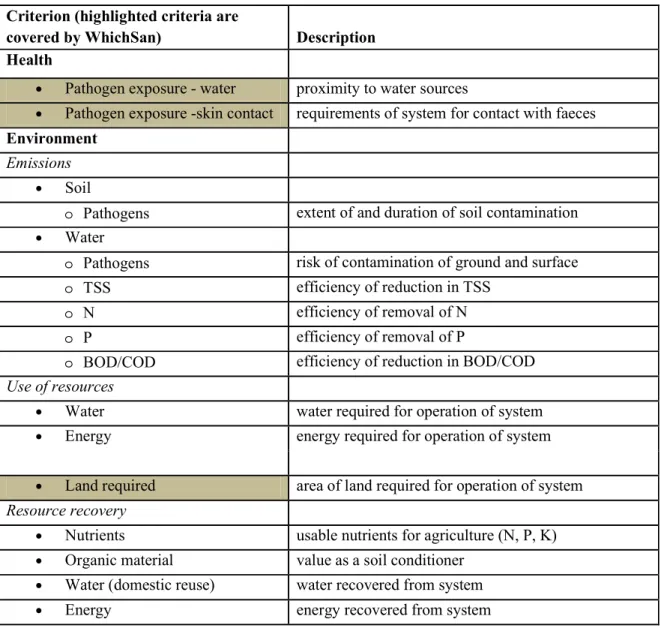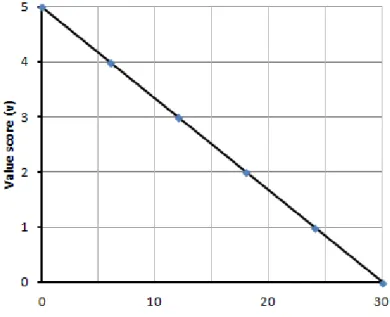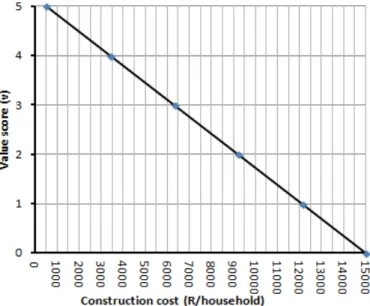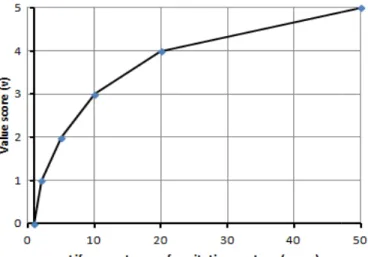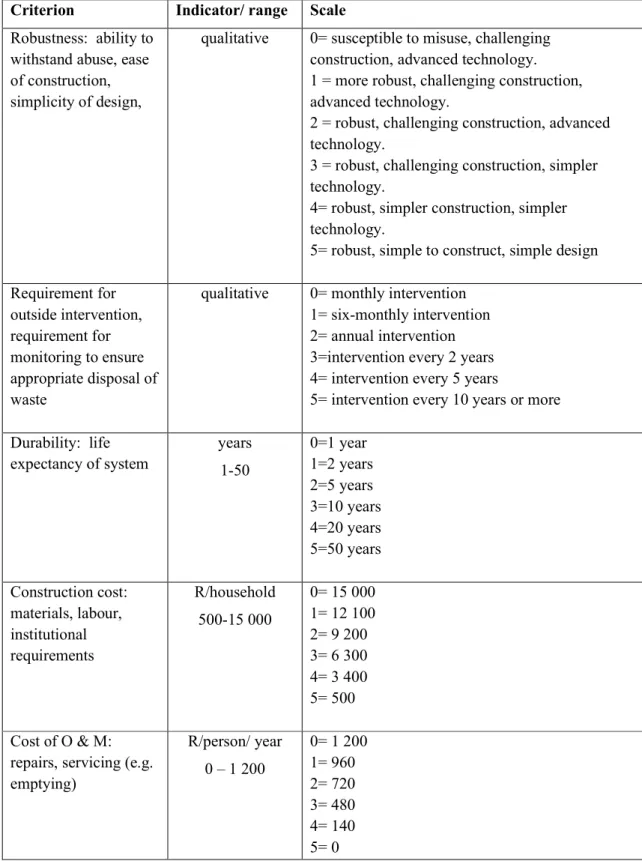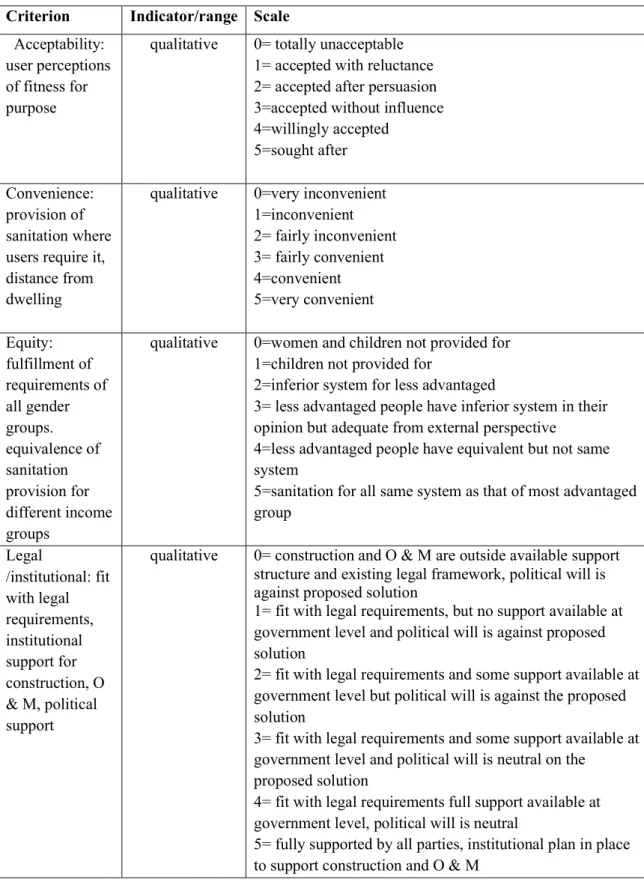The hikes in the Drakensberg have been animated by talk of toilets and decision support systems. The literature review investigated the factors that determine the success of sanitation projects and the sustainability framework in which MCDA would be structured.
Introduction
To be considered successful by society as a whole, a sanitation solution must take into account not only the needs of the community receiving services, but also the environmental impacts of waste disposal (Department of Water Affairs and Forestry, 2003, p. 45 ). Elkington (1998) brought this idea to the business world with the concept of the Triple Bottom Line “economic prosperity, environmental quality and...social justice.”
Literature review
Low cost sanitation options
- Ventilated Improved Pit Latrines
- Urine Diversion Dehydrating toilets
- Pour flush latrines
An air vent creates air currents to remove odors and to trap insects that may breed in the pit. Decomposition of excrement takes place in the pit and liquid is able to leach through the lined but unsealed walls, filling the pit at a rate of approximately 40 litres/user/year (Still and Foxon, 2012).
Sustainability criteria for sanitation systems
They compared VIP and UDDT options for sanitation provision in the eThekwini municipality. The criteria recommended by various authors for the evaluation of sanitation systems are summarized in 0.
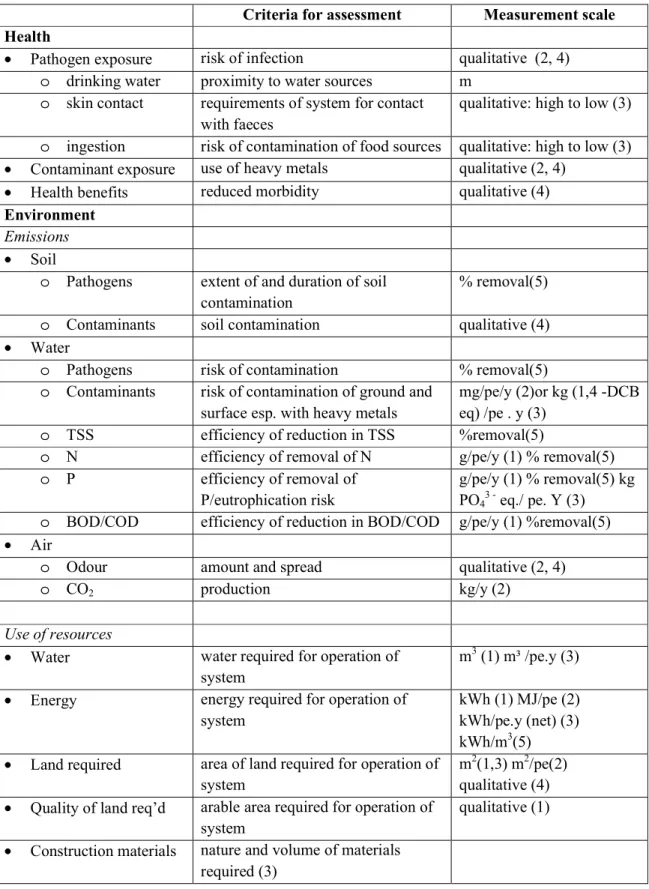
Measurement of sustainability criteria
- Measurement of environmental sustainability
- Financial aspects of sanitation provision
- Indicators of social sustainability
Summary of capital and operation and maintenance costs for different sanitation systems (after Haller et al.. The WhichSan program provides a detailed costing of the different sanitation options, allowing for different site characteristics (Still et al., 2009).
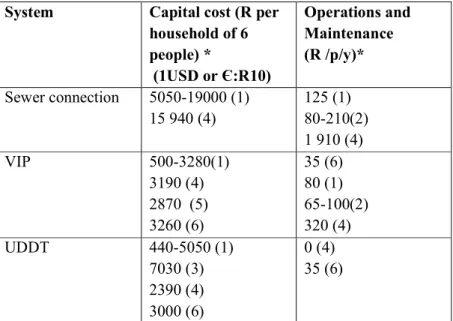
Multiple Criteria Decision Analysis
- General theory of Multiple Criteria Decision Analysis
- Different methods used in MCDA
- Multi-Attribute Value Theory (MAVT)
- Analytical Hierarchy Process (AHP)
- Outranking
- Approaches to the weighting of criteria in MCDA
- Ranking methods
- Swing weights
- Ratio weighting methods
- Importance coefficients
- Multiple Criteria Decision Analysis applied to sanitation
- Approaches to MCDA for sanitation
- Criteria and aggregation methods
Some of the methods of preference modeling described by Belton and Stewart (2002) are Multi-Attribute Value Theory (MAVT) (p. The technique used depends on the underlying nature of the data leading to the rating.
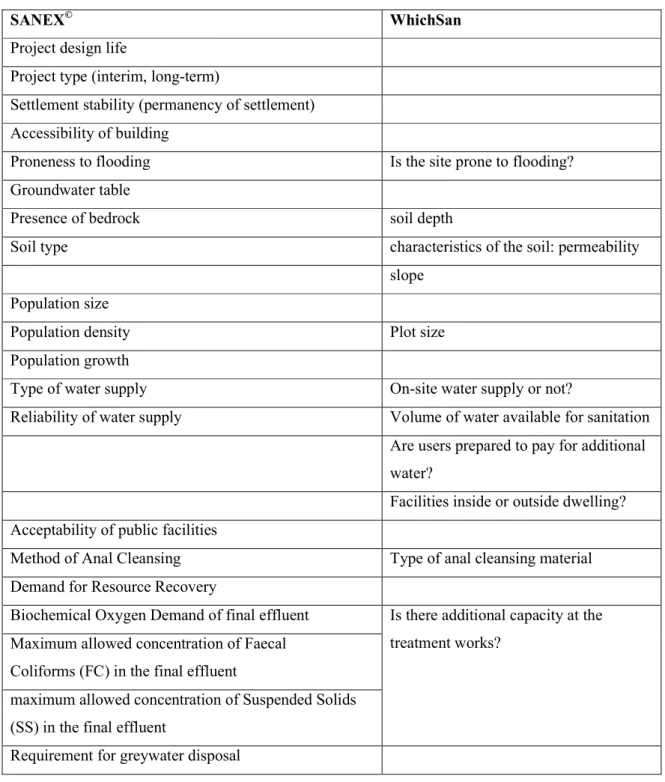
Discussion
The outcome of the MCDA was compared with the findings of local planners and other stakeholders. The effects of changes in weights on the outcome of the procedure should be investigated by sensitivity analysis.
Sanitation projects in the eThekwini Municipality
- On-site sanitation systems in the eThekwini Municipality
- Ventilated Improved Pit Latrines
- Urine Diversion Dehydrating Toilets
- Sanitation activities of the eThekwini Municipality
- VIP construction
- UDDT construction
- VIP maintenance in eThekwini
- Maintenance of UDDTs
- Current capital projects
- Research conducted in the eThekwini Municipality
- Processes taking place in on-site sanitation systems
- Costs and technological indicators from the eThekwini Municipality
- Socio-cultural aspects of the eThekwini FBS programme
- Discussion
According to Roma et al. 2011) the planning of the UDDT project started in 2002 and a pilot project was implemented in Mzinyathi in 2003. A feasibility study and a contractual system for the operation of the machine proposed by EWS have been carried out (Harrison and Wilson, 2012) . Results of the eThekwini UDDT project. 2006) investigated user perceptions of UDDTs in a number of areas across the country.
74 606 UDDTs were recorded as constructed in the eThekwini Municipality during the implementation of the UDDT program in 2003 and a survey conducted between January and May 2011.
Methodology
WhichSan
- Technical feasibility assessment
- Financial costing and feasibility assessment
The program prompts users to answer questions, the answers of which are converted into scores in a decision matrix for technical feasibility or as input for cost calculations. The answers to these questions allow the program to eliminate unfeasible options (e.g. water sewerage that is not feasible without on-site water supply, VIP latrines that are not feasible if an in-home facility is required). Feasible options are given a score of 3 (not ideal, but possible) or 5 (completely feasible) for each question and an average score of 1 – 5 is calculated.
Information sheets are available for the program, which allow users to read about the various sanitation options included in the program.
Sustainability Indicators
- Health sustainability
- Environmental sustainability
- Emissions
- Resource use
- Resource recovery
- Technological sustainability
- Financial sustainability
- Socio-cultural sustainability
What will be the impact of the sanitary system on the health of the family and community. This question aims to investigate the effect of the sanitation system on the wider community rather than on the household. What quantity and type of materials will be required to build the system.
Are there opportunities for user involvement in project planning and execution?
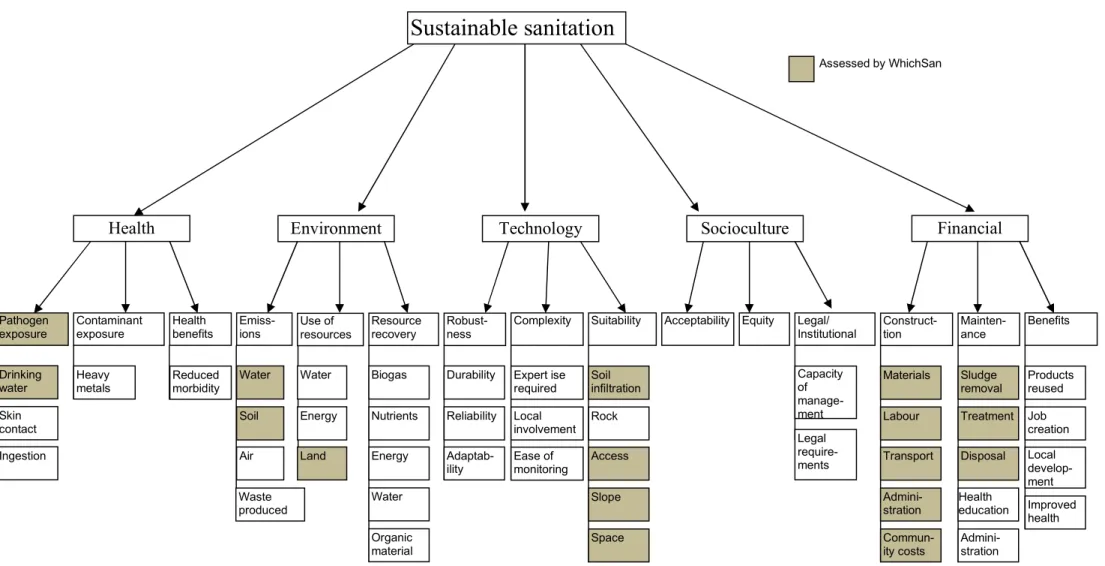
Indicators for the chosen criteria and development of value functions
- Environmental indicators
- Financial and technological indicators
- Socio-cultural sustainability
As the environmental indicators are continuous variables, these will be entered as raw scores rounded to the nearest whole number in the range described in. As the environmental indicators are continuous variables, these will be entered as raw scores rounded to the nearest whole number in the described range. in Table 4-3 and these will be. Since lower cost is more desirable, a was assigned the minimum value and 0 for the maximum value, resulting in a linear function with a negative gradient.
Similarly, in job creation, grades are assigned to the various assessments, but these are for guidance only.
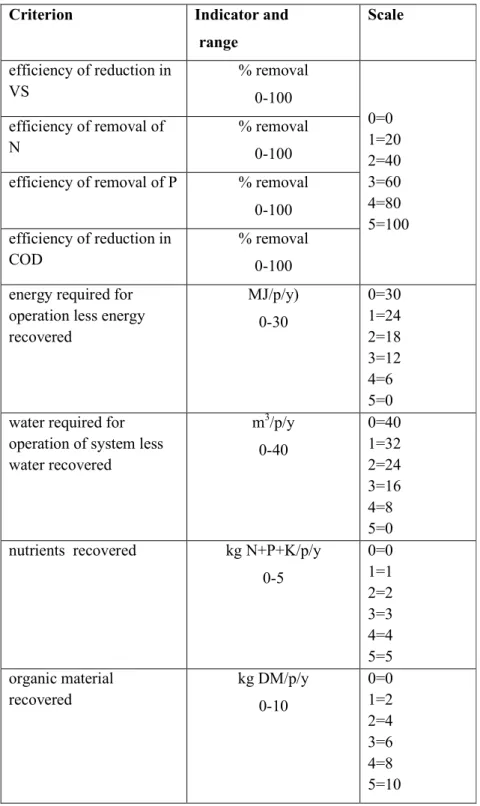
Development of the spreadsheet MCDA
- Stakeholder user interface: entering criteria weightings
- Calculation sheet
- Expert user interface: entering values for sanitation systems
- Environmental indicators
- Finance and Technology indicators
- Socio-cultural indicators
Stakeholder sheet in MCDA workbook with project details dialog box open The weighting of the different criteria is done at two levels. Dialog box for entering raw scores (scores) for environmental indicators. If some information is not available, for example if only COD or VS reduction is known (see 4.3.1), the user would weight the unknown indicator with 0 on the stakeholder sheet. . Values are entered as integers in the range between *+ and using the rotary buttons in the dialog box.
A screen shot of the Robustness and External Intervention Requirements section of the dialog box is shown in Figure 4-13.
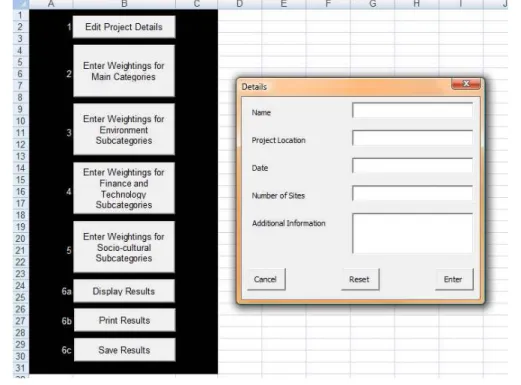
Performance of VIPs, UDDTs and Pourflush latrines against criteria
- Performance on environmental criteria
- Performance on financial and technical criteria
- Performance on socio-cultural indicators
If a sanitation project is to be initiated, community dialogue should follow a model such as Participatory Hygiene and Sanitation Transformation (PHAST), which is recommended in the National Sanitation Policy (DWAF, 2005). It is expected that it will become more difficult to convince people to accept UDDTs. VIPs are considered adequate in terms of legislation as a basic level of sanitation, but residents do not necessarily have the same opinion, hence a value of 3.
This is not the opinion of the residents, and therefore the assessment in the eThekwini situation is also 3.
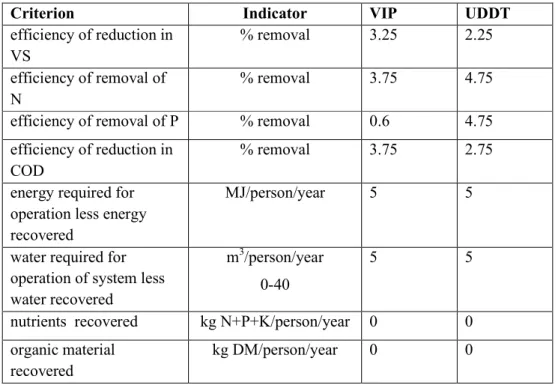
Sensitivity analysis
Scenario analysis
The remaining four sub-criteria were given a weight of 25%, as the need to use minimal energy and water was also likely in a rural scenario. The latter analysis was performed for some of the criteria that were controversial, such as the acceptability to users. The values for these sub-criteria were therefore adjusted and the overall score for GDPs was recorded.
Furthermore, the socio-cultural criterion is weighted 60% against 20% for each of the other two main criteria.
Introduction of an additional sanitation option
The sub-criterion of legal/institutional adaptation was given a lower value for both systems due to the political support component of this indicator. Finally, an experienced municipal engineer was asked to establish values and weights for the two sanitary systems under consideration and this data was used to generate a further output for the VIPs and UDDTs.
Summary and Discussion
Finally, an experienced utility engineer was asked to set values and weights for the two sanitary systems considered, and these data were used to generate a further estimate for VIP and UDDT. the expert user is accompanied by an improved understanding of sustainability issues for decision-makers, which is considered more important than the final result. It was intended that the MCDA would be used to improve the municipal engineers' understanding of the factors to be considered when implementing an intervention to improve sanitation. In this case, it is very important to carefully evaluate the non-technical aspects of the system.
However, in the survey conducted by Duncker et al, respondents indicated that they preferred to have a toilet separate from the house.
Results
Sensitivity to weightings
- Sensitivity to main category weighting
- Sensitivity to scenarios with different weightings
- and : Ecosan imperative: recycling is crucial
If the socio-cultural criterion is not given any weight, UDDTs are slightly better than VIPs. Conditions where low water and energy consumption were important issues for the environment were taken into account. If it is considered necessary for nutrients to be recycled, there is no need for the system to reduce the nutrients and volatile solids content of the faeces.
In this scenario, it can also be assumed that financial considerations carry less weight (e.g. with external funding), so the MCDA was managed with equal weights for the three main criteria ( ) and then again with a 40/20/40 division for environment /finance/socio-cultural weights.
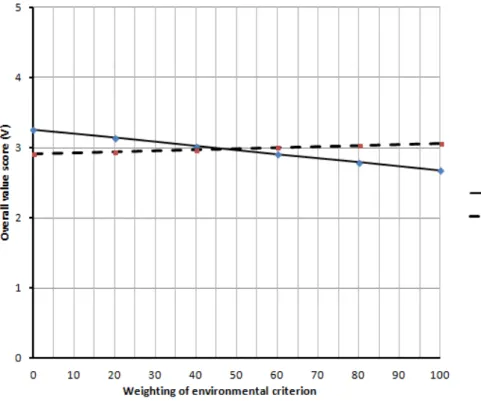
Sensitivity to changes in values
- Sensitivity to changes in UDDT values
- S , S , : Excreta from UDDT reused at household level
- S : Excreta from UDDT reused with changes to socio-cultural values
- Sensitivity to changes in VIP values
- S : Disposal of sludge to wastewater treatment works
- S : Urban resistance to on-site systems
GJ: Excreta from UDDT reused with changes in socio-cultural values. Furthermore, it could be assumed that user acceptance of UDDTs would be high if nutrients were recovered and used on site. The portion of the Sociocultural Ratings on the Expert page that reflects these changes is shown in Figure 5-6. S expects that the ratings will change as shown in Table 5-1 and that the weights will change to 20/20/60 for environment/financial/socio-cultural.
For the main categories, he suggested that environmental, financial/technological and socio-cultural criteria should be weighted 20:50:30.
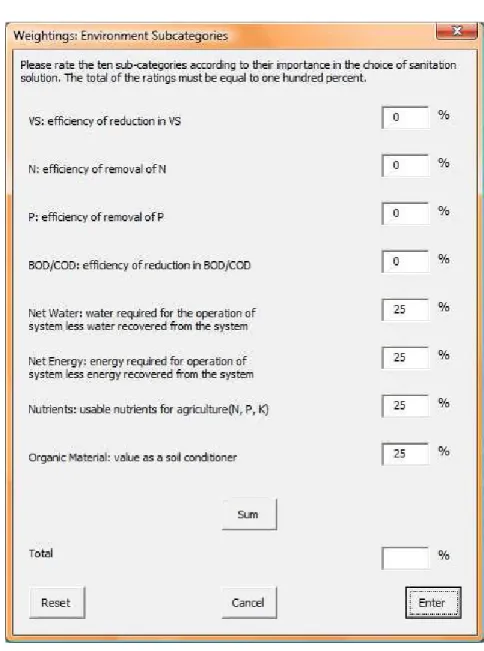
Addition of a further sanitation option
- Performance of PF on environmental criteria
- Performance of PF on financial and technical criteria
- Performance of PF on socio-cultural criteria
- Overall performance of PF
The slope emptying cost might be less than the VIP cost if a tanker or Vacutug could be used, but for MCDA the same operations and maintenance were used for both at R100/p/year. While convenience remained an individual perception and not all users preferred the flush toilet to be inside the house, this is possible if users choose this option. All other indicators were also rated 4 (see Table 5-5) because the implementation was likely to be similar to other projects of this nature.
The scores for the three systems with the adjusted construction and maintenance costs were 3.14 for VIPs, 2.94 for UDDTs, and 3.17 for pour-flush with equal weighting for all criteria.
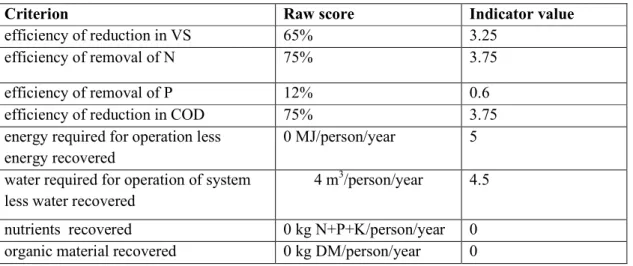
Discussion and Conclusions
- Discussion of MCDA results
- Sensitivity to main criterion weightings
- Scenario analysis
- Addition of pour-flush option
- General discussion
- MCDA as a tool in Participatory Planning
- Strengths of the MCDA
- Combination of scenario planning with MCDA
- Conclusions
- Areas for future research
- Improved value measurement
- Weight elicitation component
- Conjoint analysis combined with MCDA
- Final thought
Most of the partial value functions used were linear transformations rather than the carefully developed relationships recommended by the MCDA literature. An intervention was thus hampered by a single criterion in the MCDA – the need for legal, institutional and political support. The extent to which sanitation users are involved in the process depends, for example, on the project manager.
The MCDA in this study did not attempt to go beyond the on-site part of the sanitation solution.
Paper presented at Susan's seminar, Organizational Co-Learning to Improve Sustainable Sanitation in Sub-Saharan Africa, Johannesburg, South Africa [online]. Examining Consumer Perceptions of Water and Sanitation Services: A Case Study of Ohlange City, Durban, South Africa. 2008), Reaching Low Income Communities: Experiences from eThekwini, Durban, paper presented at the AfricaSan Conference, Durban, South Africa.
Pretoria: Water Information Network-South Africa [Online] Available:. http://www.susana.org/_resources/documents/default/2-1770-alfred-nzo-sanitation-job-creation.pdf.
